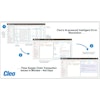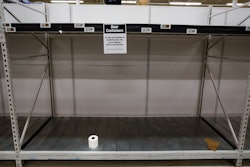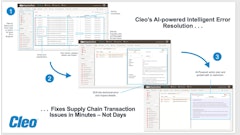
Multiple factors are converging in the automotive industry, making day-to-day supply chain management more complex than ever. There are new shortages weekly, an increased need for multi-channel and multi-level selling capabilities, as well as the continuous demand for flexibility, speed and seamless integration across multiple systems. And, above all this, e-commerce is at the forefront of distribution as customers are now buying more online.
These factors have amplified the challenges of enterprise resource planning (ERP) systems that many automotive brands currently leverage. To solve for the recent transformation in sales ordering and inventory management expectations, increased visibility across the entire order workflow is required. A robust order management solution with inventory visibility and fulfillment capabilities can help brands remain competitive and drive profitability.
Here are five ways an order management system can help you stand out in the market:
1. A seamless customer experience
Automotive original equipment manufacturers (OEM) and suppliers with spare parts and aftermarket parts are feeling the pressure to be more responsive to their customers. They’re demanding the same ease, visibility and speed they have come to expect in B2C buying. Today, those who need replacement parts must chase down retailers and dealers for the parts they need. Disconnected networks create much longer timeframes, and poorly structure catalogs inhibit inventory visibility. With the need for deeper visibility and to deliver products faster, the automotive industry is moving towards a fundamental change in the way they interact with their clients and end-users of vehicles.
Implementing a proven, flexible sales ordering system enables organizations to provide a seamless, self-service experience for their customers to see all available inventory and place a single order in one place. With delivery estimates and tracking, customers will know exactly where their order is, without any surprises. An order and inventory management system ensures automotive companies can guarantee all orders are delivered on time and in full (OTIF).
2. Simplified sales ordering
With their current ERP systems, automotive and aftermarket parts manufacturers have significant manual touchpoints in the sales ordering and validation process that lead to errors, slower order fulfillment and missed customer service level agreements (SLAs). Relying on manual processes to validate inventory in the warehouse and shipping capacity on trucks makes it nearly impossible to keep up. These ERPs were designed to be static, back-office systems for storing financial and human resource data. They weren’t built to handle growing e-commerce where inventory checks are running constantly as potentially hundreds of orders are placed per hour.
An efficient sales ordering process powered by a robust order management system can automate validations and implement complex sourcing and allocation rules to improve agility. With automated validation, the system automatically confirms that ordered parts are both in stock and compatible with a customer’s VIN number, improving the speed of order processing and reducing errors.
Automated sourcing and fulfillment rules can deliver the most cost-efficient option, selecting the one that maximizes the speed of delivery without an excessive cost. This enables the automotive manufacturer to provide higher customer service levels, while also reducing costs and improving agility.
3. A unified view of inventory
Many automotive companies struggle to create a single source of real-time inventory insights across their supply chains because they’re still relying on ERPs that cannot flexibly connect disparate systems. Complex global ecosystems of retailers, dealers, wholesalers, and agents can make it even harder to truly see and understand the end-to-end flow of inventory. If you can’t see your inventory, how can you make a promise to a customer or expect to deliver on it?
Automotive organizations need to shift from batch data in ERPs to a real-time unified view of inventory across their warehouses and divisions. A real-time view of inventory empowers companies to more accurately gauge what is available to promise, reduce backorders and improve order fulfillment. And, companies can react to unexpected demand shifts, transferring inventory to reduce delivery delays or disruptions.
Automotive companies also have complexities around inventory pooling. Order management software can ensure substitutes and additional parts are shown as available inventory for an inventory search.
4. Delivery
Legacy ERP systems with batch data updates are not designed to accurately and effectively monitor KPIs or ensure that customer orders are delivered according to SLA requirements. When major disruptions occur, key customers are at risk of potential delivery delays. If organizations cannot deliver orders OTIF, they run the risk of losing their customers.
Effectively allocating orders remains the main objective to ensure on-time delivery. Rather than fulfilling orders on a “first come, first serve” basis, automotive organizations need to prioritize based on customer SLAs. By prioritizing SLAs, organizations can enable dynamic fulfillment and shift from a process-oriented approach to one that is strategic — putting the customer first. With a focus on prioritizing SLAs, automotive organizations can gain a view into the contractual agreements at stake. These organizations are even able to obtain alerts on those SLAs at high risk with visibility into risks and problems before incurring penalties.
Automotive organizations can leverage an order management and fulfillment solution to comply with customer SLAs by easily monitoring KPIs such as OTIF. With real-time decision-making insights at every step, automotive organizations can be confident in their ability to deliver on customer promises more profitably. Through accelerated transformation and automation, improved customer service and loyalty and managed cost controls, automotive companies can ensure timely and accurate OTIF promises are comfortably met, as well as SLAs.
5. E-commerce
In the retail industry, e-commerce is nothing new. Retailers know that flexible order fulfillment is essential to meet customer expectations and keep inventory moving. Yet, many automotive organizations are not in that same position. They are still reliant on their physical locations with legacy or ERP systems — tools built for in-person protocols. These systems lack the agility, scalability and adaptability to meet today’s customers’ needs.
To remain competitive in the automotive industry, enabling effective e-commerce is essential. With manufacturing moving to a direct-to-consumer model, the transformation of B2B commerce is quickly accelerating. Buyers expect increased accuracy, availability and reliability of their orders. The ability to manage orders online provides the efficiency that customers need, and the reach that automotive organizations are looking for.
With effective integration of sales ordering, inventory management, delivery, customer experience and e-commerce, order management is entering a whole new era as it evolves to help B2B enterprises win in the automotive industry and other complex B2B environments. Question is, will your enterprise be one of the leaders benefiting from the opportunities coming from this shift?


















